
Tylopilus felleus, commonly known as the bitter bolete or the bitter tylopilus, is a fungus of the bolete family. Its distribution includes east Asia, Europe and eastern North America, extending south into Mexico and Central America. A mycorrhizal species, it grows in deciduous and coniferous woodland, often fruiting under beech and oak. Its fruit bodies have convex to flat caps that are some shade of brown, buff or tan and typically measure up to 15 cm (6 in) in diameter. The pore surface is initially white before turning pinkish with age. Like most boletes it lacks a ring and it may be distinguished from Boletus edulis and other similar species by its unusual pink pores and the prominent dark-brown net-like pattern on its stalk.

Baorangia bicolor, also known as the two-colored bolete or red and yellow bolete after its two-tone coloring scheme of red and yellow, is an edible fungus in the genus Baorangia. It inhabits most of eastern North America, primarily east of the Rocky Mountains and in season during the summer and fall months but can be found across the globe in China and Nepal. Its fruit body, the mushroom, is classed as medium or large in size, which helps distinguish it from the many similar appearing species that have a smaller stature. A deep blue/indigo bruising of the pore surface and a less dramatic bruising coloration change in the stem over a period of several minutes are identifying characteristics that distinguish it from the similar poisonous species Boletus sensibilis. There are two variations of this species, variety borealis and variety subreticulatus, and several other similar species of fungi are not poisonous.

Hortiboletus rubellus, commonly known as the ruby bolete, is a small, dainty, brightly coloured member of the family Boletaceae, with a reddish cap and stipe, and yellow pores. Like many boletes, it stains blue when cut or bruised. It is found in deciduous woodland in autumn. There is some question over its edibility, and it is reportedly of poor quality with a taste of soap. Until 2015, the species was known as Boletus rubellus.
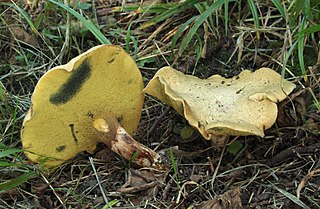
Gyrodon lividus, commonly known as the alder bolete, is a pored mushroom bearing close affinity to the genus Paxillus. Although found predominantly in Europe, where it grows in a mycorrhizal association with alder, it has also recorded from China, Japan and California. Fruit bodies are distinguished from other boletes by decurrent bright yellow pores that turn blue-grey on bruising. G. lividus mushrooms are edible.
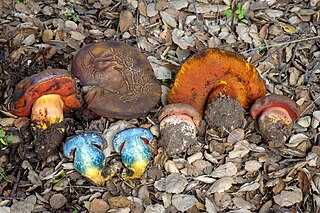
Suillellus amygdalinus is a fungus of the bolete family found in western North America. The fruit bodies, or mushrooms, are characterized by their thick, red to brown caps, red pores, and the strong bluing reaction observed when the mushroom tissue is injured or cut. The cap can reach diameters of up to 12 cm (4.7 in) and the stipe 9 cm (3.5 in) long by 3 cm (1.2 in) thick at maturity. This mushroom has been found in manzanita and madrone woodlands of central California north to southern Oregon. Although the edibility of the mushroom is not known with certainty, it may be poisonous, and is not recommended for consumption. Other similar red-pored, bluing boletes from North America, including Rubroboletus eastwoodiae, Boletus luridiformis, and B. subvelutipes, can be distinguished from S. amygdalinus either by the color of the cap, the degree of reticulation on the stipe, or by location.

Boletellus ananas, commonly known as the pineapple bolete, is a mushroom in the family Boletaceae, and the type species of the genus Boletellus. It is distributed in southeastern North America, northeastern South America, Asia, and New Zealand, where it grows scattered or in groups on the ground, often at the base of oak and pine trees. The fruit body is characterized by the reddish-pink scales on the cap that are often found hanging from the edge. The pore surface on the underside of the cap is made of irregular or angular pores up to 2 mm wide that bruise a blue color. It is yellow when young but ages to a deep olive-brown color. Microscopically, B. ananas is distinguished by large spores with cross striae on the ridges and spirally encrusted hyphae in the marginal appendiculae and flesh of the stem. Previously known as Boletus ananas and Boletus coccinea, the species was given its current name by William Alphonso Murrill in 1909. Two varieties of Boletellus ananas have been described. Although the mushroom may be considered edible, it is not recommended for consumption.

Suillus salmonicolor, commonly known as the Slippery Jill, is a fungus in the family Suillaceae of the order Boletales. First described as a member of the genus Boletus in 1874, the species acquired several synonyms, including Suillus pinorigidus and Suillus subluteus, before it was assigned its current binomial name in 1983. It has not been determined with certainty whether S. salmonicolor is distinct from the species S. cothurnatus, described by Rolf Singer in 1945. S. salmonicolor is a mycorrhizal fungus—meaning it forms a symbiotic association with the roots of plants such that both organisms benefit from the exchange of nutrients. This symbiosis occurs with various species of pine, and the fruit bodies of the fungus appear scattered or in groups on the ground near the trees. The fungus is found in North America, Hawaii, Asia, the Caribbean, South Africa, Australia and Central America. It has been introduced to several of those locations via transplanted trees.

Butyriboletus regius, commonly known as the royal bolete or red-capped butter bolete, is a basidiomycete fungus of the genus Boletus found in China and Europe. B. regius has a pink cap, yellow flesh, and a reticulate pattern on the stem. Harry D. Thiers described a similar mushroom from California as B. regius, though it is not the same species. B. regius in Europe does not stain when exposed to air, or stains weakly, but the California species stains blue. Both European and California species are considered choice edibles.

Tylopilus alboater, called the black velvet bolete, by some, is a bolete fungus in the family Boletaceae. The species is found in North America east of the Rocky Mountains, and in eastern Asia, including China, Japan, Taiwan, and Thailand. A mycorrhizal species, it grows solitarily, scattered, or in groups on the ground usually under deciduous trees, particularly oak, although it has been recorded from deciduous, coniferous, and mixed forests.
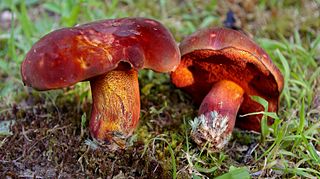
Boletus rubroflammeus is a species of bolete fungus in the family Boletaceae. First described from Michigan in 1971, it is found in the eastern United States and Mexico, where it grows in a mycorrhizal association with hardwood trees. The fruit bodies (mushrooms) of the fungus have caps that are deep red to purplish red, and dark red pores. The stem has coarse, dark red reticulations and a narrow yellow area at the top. All parts of the mushroom quickly stain blue when injured or cut. Lookalikes include Boletus flammans, a lighter-colored species that grows with conifers. Other similar species can be distinguished by differences in distribution, morphology, staining reaction, and microscopic characteristics. Boletus rubroflammeus mushrooms are poisonous, and can cause gastrointestinal distress if consumed.

Boletus curtisii is a species of fungus in the family Boletaceae. It produces small- to medium-sized fruit bodies (mushrooms) with a convex cap up to 9.5 cm (3.7 in) wide atop a slender stem that can reach a length of 12 cm (4.7 in). In young specimens, the cap and stem are bright golden yellow, although the color dulls to brownish when old. Both the stem and cap are slimy or sticky when young. On the underside of the cap are small circular to angular pores. The mushroom is edible, but not appealing. It is found in eastern and southern North America, where it grows in a mycorrhizal association with hardwood and conifer trees. Once classified as a species of Pulveroboletus, the yellow color of B. curtisii is a result of pigments chemically distinct from those responsible for the yellow coloring of Pulveroboletus.
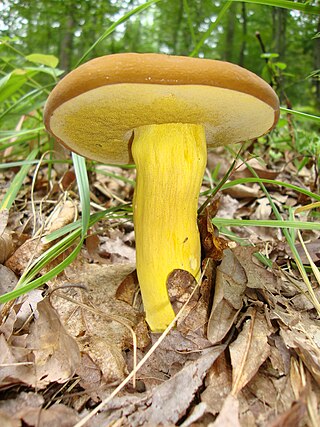
Boletus auripes, commonly known as the butter-foot bolete, is a species of bolete fungus in the family Boletaceae. First described from New York in 1898, the fungus is found in eastern Asia, Central America, and eastern North America from Canada to Florida. It is a mycorrhizal species and typically grows in association with oak and beech trees.

Aureoboletus auriflammeus, commonly known as the flaming gold bolete, is a species of bolete fungus in the family Boletaceae. Described as new to science in 1872, it is found in eastern North America, where it grows in a mycorrhizal association with oaks. The caps of the fruit bodies are golden orange, with a yellow pore surface on the underside, and a reticulated (network-like) stem. The edibility of the mushroom is not known.

Neoboletus pseudosulphureus is a species of bolete fungus in the family Boletaceae. It is found in Europe, Central America, North America, and India, where it grows in deciduous and mixed forests. Initially uniformly yellow in color, all external surfaces of the fruit body undergo a variety of discolorations as it matures.

Boletus carminiporus is a species of bolete fungus in the family Boletaceae. Described as new to science in 1998, the species is found in the southern United States where it grows in a mycorrhizal association with various trees in mixed forests.
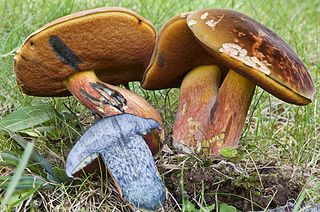
Boletus subvelutipes, commonly known as the red-mouth bolete, is a bolete fungus in the family Boletaceae. It is found in Asia and North America, where it fruits on the ground in a mycorrhizal association with both deciduous and coniferous trees. Its fruit bodies (mushrooms) have a brown to reddish-brown cap, bright yellow cap flesh, and a stem covered by furfuraceous to punctate ornamentation and dark red hairs at the base. Its flesh instantly stains blue when cut, but slowly fades to white. The fruit bodies are poisonous, and produce symptoms of gastrointestinal distress if consumed.

Pulveroboletus ravenelii, commonly known as Ravenel's bolete or the powdery sulfur bolete, is a species of bolete fungus in the family Boletaceae. Described as new to science in 1853, the widely distributed species is known from Asia, Australia, North America, Central America, and South America. Mycorrhizal with oak, the fungus fruits on the ground singly, scattered, or in groups in woods. Fruit bodies (mushrooms) have convex to flat, yellowish to brownish-red caps up to 10 cm (4 in) in diameter. On the cap underside, the pore surface is bright yellow before turning dingy yellow to grayish brown with age; it stains greenish blue then grayish brown after injury. A cottony and powdery partial veil remains as a ring on the stipe. The mushrooms are edible, and have been used in traditional Chinese medicine and for mushroom dyeing.

Buchwaldoboletus lignicola is a species of bolete fungus in the family Boletaceae native to Europe and North America. Found on wood, it is actually parasitic on the fungus Phaeolus schweinitzii. It has a convex yellow- to rusty brown cap, yellow to yellow-brown pores and stipe, and a brown spore print. Its edibility is unknown.

Boletus subluridellus is a species of bolete fungus in the family Boletaceae. Described as new to science in 1971 by American mycologists, the bolete is found in the eastern United States and Canada. It grows on the ground in coniferous and mixed forests in a mycorrhizal association with deciduous trees, especially oak. The fruit bodies (mushrooms) have orangish-red, broadly convex caps that are up to 10 cm (3.9 in) in diameter, with small, dark reddish pores on the underside. The pale yellow stipe measures 4–9 cm (1.6–3.5 in) long by 1.5–2.3 cm (0.6–0.9 in) thick. All parts of the fruit body will quickly stain blue when injured or touched.
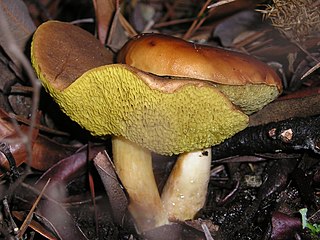
Boletus amyloideus is a rare species of bolete fungus in the family Boletaceae. It was described as new to science in 1975 by mycologist Harry D. Thiers, from collections made in California. It fruit bodies have a convex to somewhat flattened reddish-brown cap measuring 3–6 cm (1.2–2.4 in) in diameter. The pore surface on the cap underside is bright yellow, with small angular pores and tubes measuring 4–8 mm long. The spore print is olive-brown; basidiospores are smooth, amyloid, spindle shaped to ellipsoid, and have dimensions of 13–16 by 4.5–5.5 µm. The bolete is known only from coastal California, where it grows on the ground in mixed forests. Its edibility is unknown.





















